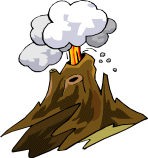
Volcanoes
 Atmospheric pollution from major volcanic eruptions can influence the global climate over one to two years. Explosive volcanic eruptions can inject large quantities of dust and sulphur dioxide, in gaseous form, to an altitude of over 10 miles into the atmosphere (the stratosphere), where the sulphur dioxide is rapidly converted into secondary sulphuric acid aerosols. Whereas volcanic pollution from smaller eruptions, ejected only a few miles into the atmosphere, is removed within days by rain, the volcanic dust and aerosols in the stratosphere may remain for up to two years, gradually spreading over much of the globe by winds.
Atmospheric pollution from major volcanic eruptions can influence the global climate over one to two years. Explosive volcanic eruptions can inject large quantities of dust and sulphur dioxide, in gaseous form, to an altitude of over 10 miles into the atmosphere (the stratosphere), where the sulphur dioxide is rapidly converted into secondary sulphuric acid aerosols. Whereas volcanic pollution from smaller eruptions, ejected only a few miles into the atmosphere, is removed within days by rain, the volcanic dust and aerosols in the stratosphere may remain for up to two years, gradually spreading over much of the globe by winds.
Volcanic pollution results in a 5 to 10% reduction in direct sunlight, largely through scattering as a result of the highly reflective sulphuric acid aerosols. Large eruptions, such as the Mount Pinatubo in the Philippines which occurred in 1991, can bring about a short but noticeable global cooling of up to 0.3°C.
It is possible the longer term changes in the amount of volcanic activity on the Earth may explain incidences of longer term climate change during Earth History. 66 million years ago, at about the same time as the extinction of the dinosaurs, massive amounts of lava were being erupted on the Indian sub-continent, at that time drifting North towards Asia, having separated from Australia and Antarctica. These immense lava flows, now known as the Deccan Traps, released huge quantities of gases, including sulphur dioxide and carbon dioxide. Theories concerning the climatic impact of such emissions vary. Some suggest that an initial severe global cooling may have occurred as result of a reduction in the amount of incoming sunlight, scattered and reflected by the secondary sulphuric acid aerosols. Others suggest that the extra volumes of carbon dioxide enhanced the Earth's greenhouse effect, causing a longer term global warming. Whatever the climatic effects were due to, it is likely that they were responsible for the mass extinction of living species that occurred at this time, including not just the death of the dinosaurs, but many other living organisms on land and in the oceans.
Websites
Other topics
• Dinosaur Extinction
• Geological Perspective
• NASA GISS
• NASA GISS
• DKRZ
• Introduction
• Atmosphere
• Causes
• Climate Forcing
• Climate System
• Comets
• Continental Drift
• Earth's Orbit
• Energy Balance
• Evidence
• Feedback
• Global Warming
• Greenhouse Effect
• Greenhouse Gases
• Historical Records
• Ice Ages
• Ice Cores
• Instrumental Records
• Interglacials
• Little Ice Age
• Modelling
• Mountains
• Oceans
• Palaeoclimate Change
• Palaeoclimate Records
• Palaeoclimatology
• Sea Sediments
• Sun
• Time
• Tree Rings
• Volcanoes
 Print Topic
Print Topic